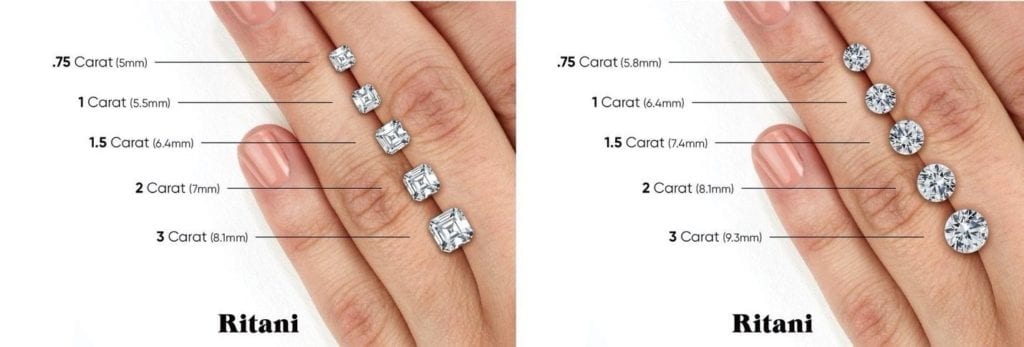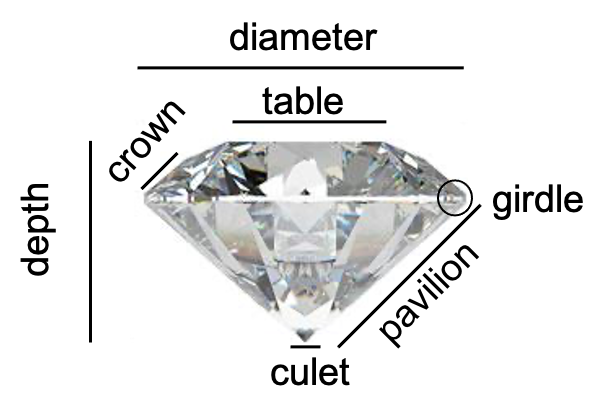How To Tell The Size Of A Diamond
IGS may receive client referral fees from the companies listed in this folio. Learn more.
Diamond Measurements: What You Should Know Before You Buy
If y'all're shopping for the perfect diamond, think across the carats. A diamond's measurement is more just carats–consider its shape, cutting, and length-to-width ratio besides. With a niggling research, it's easy to observe a diamond where all of these factors work together to maximize the diamond's beauty.
Carats and Diamond Size

When it comes to a diamond's measurements, carats and size are two dissimilar things. A diamond's size is how large the diamond volition look when viewed from higher up, while carats depict how much the diamond weighs. Ane carat is equal to 0.2 grams, so a 5-carat diamond weighs ane gram.
A diamond's size is described in millimeters (mm). These measurements are roughly comparable to carats. A 1-carat round diamond is typically half-dozen.v mm, while a 1.25-carat round diamond is 6.8 mm. For square-cut diamonds like princess, cushion, and asscher, 1-carat is typically 5.5 mm and a 1.25 carat is 6 mm.
Compare these two one.01-carat diamonds. On the left is an oval-cut diamond, seven.96 mm long and 5.six mm wide. On the right, a marquise-cut diamond that is nine.83 mm long and 5.05 mm wide. Both diamonds are the aforementioned weight, but they look like very unlike sizes. From James Allen.
Fancy shaped diamonds similar oval, emerald, pear, marquise, and radiant are typically described by their length. One carat emerald and radiant diamonds are 7 mm long, while 1-carat oval and pear diamonds are 7.7 mm long. Marquise diamonds are long and thin in comparison–a 1-carat marquise diamond is 10 mm and a 1.25-carat is 11 mm long.
Length to Width Ratio
A 0.82-carat emerald-cut diamond from Blue Nile. The length to width ratio of 1.41 gives this emerald-cutting diamond its classic rectangular shape.
Length to width ratio describes the proportions of a diamond–whether information technology's perfectly circular, square, oval, or rectangular. The ratio calculated by dividing a diamond'southward length by its width. The 0.82-carat emerald-cut diamond shown to a higher place is six.24 mm long and iv.41 mm wide, so it has a length to width ratio of 1.41.
The ideal length to width ratio varies depending on the diamond'southward shape. The length and width of round and square diamonds should exist almost identical, giving them a length to width ratio shut to 1.0. Rectangular and oval-shaped diamonds should be longer than they are wide, with length to width ratios ranging from 1.25 to ii.
Each diamond shape has a range of ideal length to width ratios. Diamonds within these ranges volition be the most proportional and elegant:
- Round: length to width ratio of 1.0 – ane.05
- Princess: length to width ratio of i.0 – 1.04
- Cushion: length to width ratio of ane.0 – 1.08
- Emerald: length to width ratio of 1.iii – ane.four
- Oval: length to width ratio of 1.25 – one.5
- Pear: length to width ratio of one.45 – 1.75
- Marquise: length to width ratio of 1.85 – 2.0
Diamond Proportions and Advent

The depth and table percentage are 2 other measurements that affect a diamond's brilliance and sparkle. Depth percentage is a diamond'south depth (or height) divided by its diameter.
Diamonds that are short and wide have a low depth per centum and are considered to exist shallow. Shallow diamonds may appear larger from above, but they don't reflect light well, giving them a dark advent.
Diamonds with a loftier depth percentage are tall and wide. Deep cut diamonds often have a dull appearance, as light escapes out of the bottom of the diamond. Make sure your diamond has the maximum sparkle and brilliance by choosing a diamond within these depth percentage ranges:
- Round: 59 – 63%
- Princess: 68 – 74%
- Cushion: 61 – 68%
- Emerald: 61 – 68%
- Oval: less than 63%
- Pear: less than 68%
- Marquise: 58 – 62%
A diamond'southward table is the apartment facet on the top of the diamond. When light enters a diamond, the table refracts the light and sends it to the rest of the diamond's facets, making the diamond sparkle. The table percentage is calculated by dividing a diamond's tabular array width by its diameter.
The ideal table percentage varies depending on the diamond's shape. Light won't properly reflect off diamonds with tabular array percentages that are too high or as well low, resulting in a slow, lackluster diamond. Look for a diamond within the following table percentage ranges:
- Circular: 54 – 57%
- Princess: 69 – 75%
- Cushion: less than 68%
- Emerald: 61 – 69%
- Oval: 53 – 63%
- Pear: 53 – 65%
- Marquise: 53 – 63%

A 0.70-carat princess cut diamond with non-ideal proportions. The length to width ratio is 1.07, so the diamond is slightly rectangular instead of perfectly square. The tabular array percentage is 79% (higher than the ideal range of 69 – 75%) and the depth percent is 72%. From Bluish Nile.
A diamond'southward girdle is the belt between the crown and the pavilion. Girdle thickness is the acme of this belt and ranges from "extremely sparse" to "extremely thick":
- Extremely Sparse
- Very Thin
- Sparse
- Medium
- Slightly Thick
- Thick
- Very Thick
- Extremely Thick
Look for a diamond in the thin to slightly thick range. Girdles that are too thin could chip or go plain-featured by the prongs property the diamond in a ring. Girdles that are too thick tin can don't reflect calorie-free every bit well and hide weight, making the diamond announced smaller than what'south normal for its carat size.

Carats and Price
Two-carat diamonds command a shockingly loftier price. On the left, the i.005-carat H color VS1 ideal cut circular diamond is $seven,660.00. On the right, the two.09 carat IF ideal cutting round diamond is $97,846. From Brian Gavin.
Carat has a huge influence on a diamond's price. The larger the diamond, the more than it will toll. In fact, diamond price increases exponentially as the carats increase. Big diamonds are rare and must be cut with farthermost care to preserve their weight, which drives up the cost. The price of a 2-carat circular diamond is virtually iii.5 times the price of a i-carat diamond with identical backdrop!
The actual number of carats impacts diamond price too. One carat diamond rings are incredibly pop, and so diamonds that are exactly i-carat are priced at a premium. Wait for a diamond slightly above or slightly below the 1-carat marker to save on price. The aforementioned applies to diamonds that are at a quarter and half-carat sizes, like one.25 or 1.l carats. You lot'll probable stop up paying much more for a diamond that is 1.25 carats compared to a similar diamond that is 1.21 carats, but the size difference is negligible.
Evaluating Diamond Measurements Online
A 0.92-carat ideal cutting round diamond from White Flash. White Wink provides full specifications for each diamond.
With all of the numbers, ratios and percentages to keep runway of, evaluating a diamond'due south measurement may seem like a daunting job. Fortunately, diamond graders have done some of the hard work for you. Diamonds with high cut grades–very good, first-class, or ideal–will have the best proportions. The cutting is the most of import of the 4C's when information technology comes to a diamond'southward appearance and well-cut diamonds will give y'all the traditional sparkly diamond.
When you do find that perfect diamond, wait at information technology in 3D and read all of the information provided online. Retailers like James Allen, Blue Nile, Brian Gavin, White Flash, Ritani, and With Clarity include the cutting rating, length to width ratio, depth percentage, tabular array pct, and girdle thickness for each diamond. Virtually of these retailers accept an option to talk with an practiced if you demand some buying advice.
How To Tell The Size Of A Diamond,
Source: https://www.gemsociety.org/article/diamond-measurements/
Posted by: rossantouch.blogspot.com


0 Response to "How To Tell The Size Of A Diamond"
Post a Comment